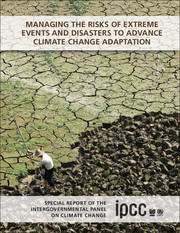 Managing the Risks of Extreme Events and Disasters to Advance Climate Change Adaptation
Managing the Risks of Extreme Events and Disasters to Advance Climate Change Adaptation from Section III
Published online by Cambridge University Press: 05 August 2012
Executive Summary
Case studies contribute more focused analyses which, in the context of human loss and damage, demonstrate the effectiveness of response strategies and prevention measures and identify lessons about success in disaster risk reduction and climate change adaptation. The case studies were chosen to complement and be consistent with the information in the preceding chapters, and to demonstrate aspects of the key messages in the Summary for Policymakers and the Hyogo Framework for Action Priorities.
The case studies were grouped to examine types of extreme events, vulnerable regions, and methodological approaches. For the extreme event examples, the first two case studies pertain to events of extreme temperature with moisture deficiencies in Europe and Australia and their impacts including on health. These are followed by case studies on drought in Syria and dzud, cold-dry conditions in Mongolia. Tropical cyclones in Bangladesh, Myanmar, and Mesoamerica, and then floods in Mozambique are discussed in the context of community actions. The last of the extreme events case studies is about disastrous epidemic disease, using the case of cholera in Zimbabwe, as the example.
The case studies chosen to reflect vulnerable regions demonstrate how a changing climate provides significant concerns for people, societies, and their infrastructure. These are: Mumbai as an example of a coastal megacity; the Republic of the Marshall Islands, as an example of small island developing states with special challenges for adaptation; and Canada's northern regions as an example of cold climate vulnerabilities focusing on infrastructures.
To save this book to your Kindle, first ensure [email protected] is added to your Approved Personal Document E-mail List under your Personal Document Settings on the Manage Your Content and Devices page of your Amazon account. Then enter the ‘name’ part of your Kindle email address below. Find out more about saving to your Kindle.
Note you can select to save to either the @free.kindle.com or @kindle.com variations. ‘@free.kindle.com’ emails are free but can only be saved to your device when it is connected to wi-fi. ‘@kindle.com’ emails can be delivered even when you are not connected to wi-fi, but note that service fees apply.
Find out more about the Kindle Personal Document Service.
To save content items to your account, please confirm that you agree to abide by our usage policies. If this is the first time you use this feature, you will be asked to authorise Cambridge Core to connect with your account. Find out more about saving content to Dropbox.
To save content items to your account, please confirm that you agree to abide by our usage policies. If this is the first time you use this feature, you will be asked to authorise Cambridge Core to connect with your account. Find out more about saving content to Google Drive.